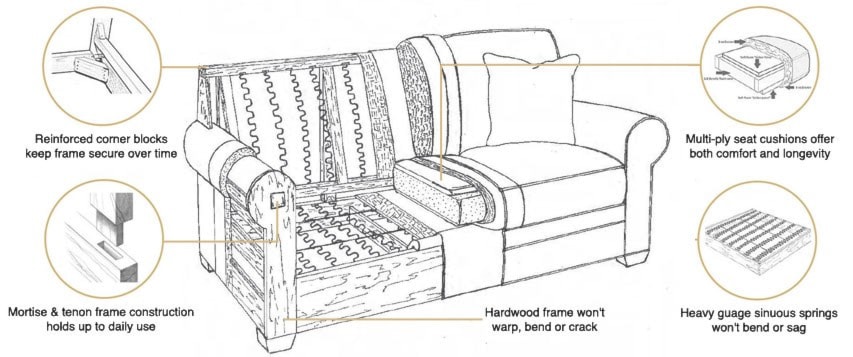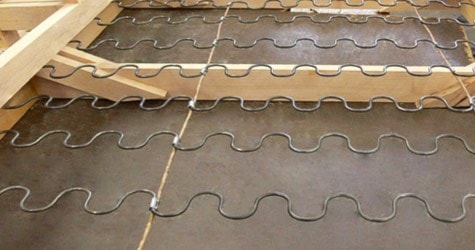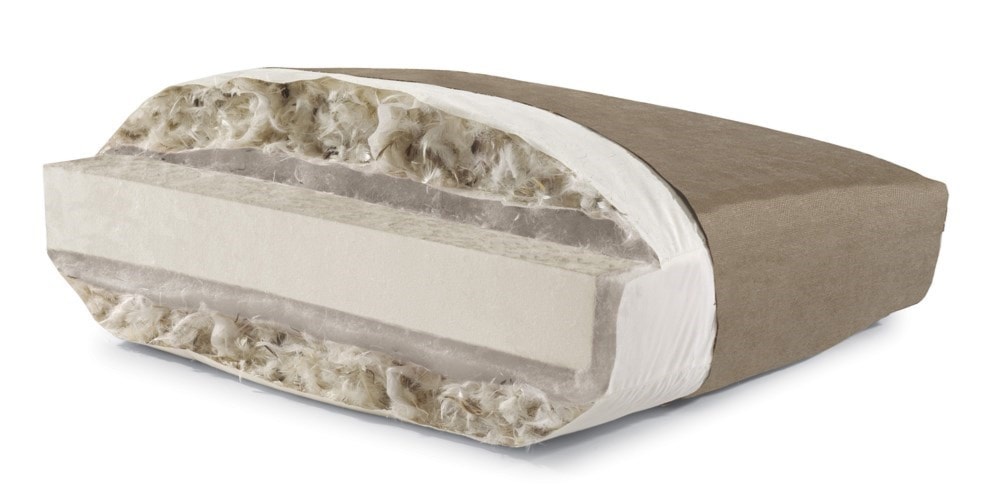
Five Key Features of a Quality Sofa
by Nick, Digital Specialist | June 16, 2021
We see this all the time: a customer sees two sofas that look almost identical. One is $500, and the other is $2500. The salesperson says that the $2500 sofa is "better quality"...but what does that really mean? Let's examine five key factors that contribute to a sofa's quality.
Our customers run into this issue all the time: they see two sofas that look almost identical in the showroom. One of them costs $500, and the other costs $2500. One of them must be overpriced, right? Wrong! You really do get what you pay for. Your salesperson might say that the $2500 sofa is “better quality,” but what does that really mean? Let’s examine some of the key features that will help you differentiate the quality.
The Frame: this is where it all starts. If you’re looking “under the hood” to see some real differences, this is a great thing to check out. Here are some things you’ll want to look for:
- What’s it made out of? Most frames are made of kiln-dried hardwood, which means the wood has been dried out before being cut and assembled. This removes any moisture and prevents warping and cracking. Some more expensive manufacturers may make this hardwood into plywood by pressing multiple layers together, usually with the grains of two layers perpendicular for added strength. Sometimes, you’ll see less expensive pieces made of medium-density fiberboard (MDF) or pressboard.
- How is it put together? Most frames that are of a medium quality use a combination of glue, screws, and staples to assemble the pieces of the frame together and give it strength. Another step further than that in terms of quality is a joinery method call mortise-and-tenon; in this method, a tab (the tenon) is cut out of the wood that is designed to fit into a specifically-fitted slot (the mortise) on another piece of wood, joining them together precisely.
- Is it reinforced? When the frame is assembled, some manufacturers will reinforce the spots where two pieces are joined together with an extra block or other piece of wood. This is called corner blocking, and can make a frame a lot stronger. You’ll also find corner blocking in the drawers of many bedroom dressers, as it gives the bottom of the drawer added strength to compensate for additional weight.

The Suspension: This refers to the pieces that are stretched or inserted in the middle of the frame, to give the seat and back cushions a flat, supportive base. The suspension actually contributes more to the comfort of a sofa than the cushions! The most common types of suspension:
- Sinuous springs: this is a series of thick, S-shaped wires that are placed across the sofa to give it support. Short, thin rods are tied in between to give support and strength both horizontally and vertically. Most mid-priced sofas feature this support system.
- Eight-way hand-tied: many sofa traditionalists (if there is such a thing) swear by this suspension method, where hourglass-shaped coils are knotted together by hand. This method is found on more expensive pieces but is less common in more recent designs.
- Drop-in coils: as the name implies, a whole rectangular grid of coils is fitted right into the middle of the frame. This is a less expensive suspension method, and can often result in squeaking due to the metal-on-metal construction.
- Steel band: in this suspension method, a flexible piece of steel with a metal support system is fitted into the middle of the frame. This is a method only found in certain high-quality sofas. It can contribute to a longer life for the sofa, but can make the sofa feel a little firmer than some of its counterparts.
- Webbing: imagine the material that’s used in your car seat belt stretched in both directions across the frame- this is what webbing is. This is more commonly found in dining chairs and outdoor furniture but is occasionally found on sofas.

The Seat Cushion: this is what most people are looking to test when they sit on a piece of furniture, even though all of the above mentioned factors all contribute to overall comfort. There are many different materials a manufacturer can use to construct a seat cushion, including:
- Poly-wrapped foam: starting with the most common, these cushions feature a middle layer of dense foam, which is wrapped in polyester and a ticking to keep it all in place. This is most commonly found in mid-priced sofas, and is a reliable and low-maintenance option. One thing to ask about is the density of the foam- the industry standard is about 1.8 but you’ll find as low as 1.5 and as high as 2.5.
- Down cushions: there is a common misconception that down cushions are filled with a whole bunch of goose feathers and nothing else- this is not the case! Down or down-blend cushions will have the same foam core mentioned above, but there will be a layer of down feathers along the top and bottom of the seat cushion, giving it a softer feel and a more lived-in look. Just be aware that down cushions can sometimes look wrinkly!
- Innerspring: this type of seat cushion will feature the foam core as mentioned above, but will have coils in the middle of the foam (sort of like your mattress) to reinforce the cushion and give it a more springy, bouncy feel.

The Back Cushion: the back cushion of a sofa will generally be filled with polyester fiber. Entry-grade sofas will just have this fiber blown into the back cushion, but better-quality pieces will have the fiber in a separate bag so it doesn’t necessarily fall everywhere when the cushion is opened. In a top-quality piece, you’ll find that the interior bag has separate channels so there’s less of a chance of the fiber moving and sinking.
The Upholstery: fabrics that are used for sofa upholstery can vary widely in terms of durability. One thing to ask about is the double-rub test; fabrics are rubbed with a machine back and forth- that’s one double-rub. They count the number of double-rubs it takes to break through the fabric, and that number can help determine its durability. In addition, it definitely helps to look for a fabric with a tight weave, so it’s less prone to punctures and pulls. By the way, most fabrics are prone to pilling to some degree- when the small fibers ball up on top of the sofa. This is not a defect!
If you’re looking for a patterned sofa, be on the lookout for how the pattern lines up. It’s especially noticeable in striped patterns. Better-quality furniture will align the pattern from the seat back, to the seat, and down the front of the piece.

As you can see, there are a ton of factors that go into determining the quality of a piece. Ask your salesperson about these details so you can feel comfortable that you’re getting your money’s worth for your new sofa!

BROWSE BY TAG:
ALL CATEGORIES:
MOST POPULAR:
MOST RECENT:





